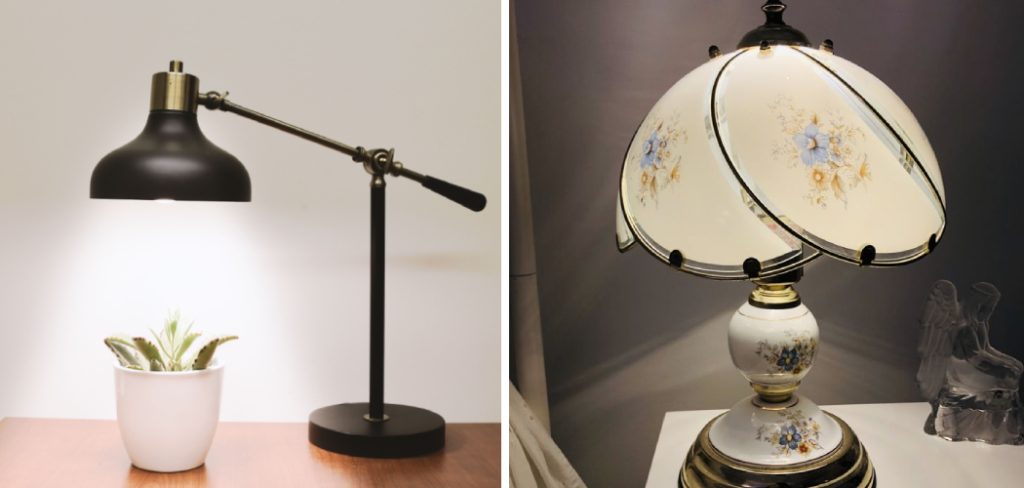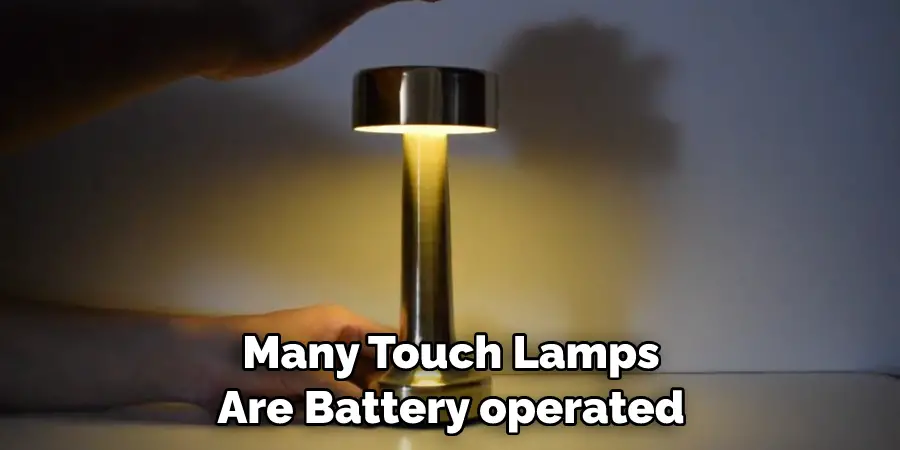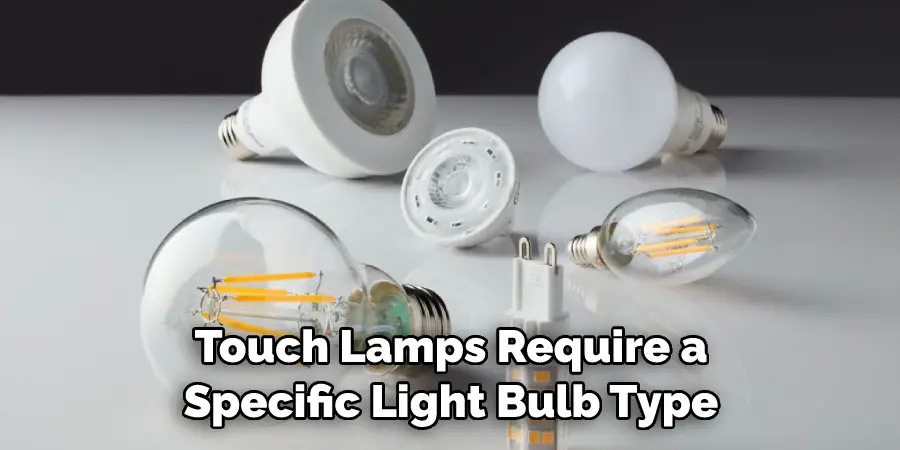Touch lamps are a common household item that has become increasingly popular over the years because of their convenience and ease of use. They are also known as “touch-sensitive” lamps and a touch-activated lighting system. When you touch the base or any other lamp part, it turns on or off. But have you ever wondered how do touch lamps work? In this blog post, we will discuss how touch lamps work and what makes them so unique.

Why It’s Important to Understand How Touch Lamps Work?
Touch lamps have become increasingly popular in households due to their ease of use and convenience. However, understanding how touch lamps work is not only important for the sake of curiosity but also for safety.
Touch lamps work by using a touch-sensitive sensor to turn the light on and off. It is important to know that touch lamps have a weak electric current running through them at all times, which means they can pose a risk of electric shock if not handled properly.
By understanding how touch lamps work, we can ensure that we use them safely and efficiently while also appreciating the technology that goes into making them work so seamlessly.
How Do Touch Lamps Work? A Comprehensive Guide
1. Understand the Touch Lamps Work
To understand how touch lamps work, it’s essential to know that they contain a small touch sensor built into their base. This sensor sends a signal to the lamp’s internal circuitry when it detects a change in the electrical current in the user’s body, such as when they touch the lamp’s base. The circuitry then responds by turning the lamp on or off, depending on the user’s touch. This process is quick, and the lamp responds almost immediately when touched.
2. The Touch Sensor Work
The touch sensor inside a touch lamp typically consists of a metal plate that’s connected to a wire and wrapped around the lamp’s base. When you touch the lamp, your body becomes a conductor of electricity, and this current travels through the wire, generating a signal to the lamp’s circuit board. This chip then reads the signal and decides whether to turn the lamp on or off.
3. The Circuit Type
Another important aspect of touch lamp circuitry is the triac. This is the device responsible for controlling the flow of current to the lamp’s light bulb. When the touch sensor sends a signal to the circuitry, the triac is activated, cutting off or allowing the current to pass through the lamp, depending on the user’s touch. In other words, the triac controls the lamp’s intensity and brightness.
4. Type of Lamps
There are two types of touch lamps: ungrounded and grounded. Ungrounded touch lamps are connected to electrical systems that aren’t grounded, while grounded touch lamps are connected to electrical systems that are grounded. Grounded touch lamps usually offer better protection against electrical shocks than ungrounded ones, but both are generally safe.

5. You Can Be Dimmed by Touching the Base
One fascinating thing about touch lamps is that they can also be dimmed by touching the base for an extended period, and the lamp will start to dim slowly. This is due to the lamp’s circuitry, designed to interpret holding the base as a command to lower the lamp’s brightness. The light will then dim until the user releases the base.
6. Operate by Touch and Switch
Touch lamps can be operated both with the touch sensor and with a traditional switch, depending on which one you prefer. If you’d like to use a switch, all you have to do is connect it to the lamp’s wiring system, as instructed by the manufacturer. It’s important to make sure the switch is compatible with the lamp, as different types of switches may require different wiring.
7. Safety Consideration
Lastly, it’s important to keep in mind that touch lamps need to be used safely. Always ensure all wiring is correctly insulated and the switch operates properly before using the lamp. It’s also essential to choose a lamp that meets safety standards and is suitable for the environment in which it will be used. By following these safety guidelines, you can enjoy your touch lamp for years.
That’s it! You’ve now learned how do touch lamps work. With this knowledge, you can enjoy the convenience and efficiency of using one in your home or office safely and with confidence.
5 Considerations Things When You Need to Understand How Touch Lamps Work?
1. The Different Types of Touch Lamps
Touch lamps come in many forms, from simple battery-operated accent lights to wireless models that use infrared technology. Popular designs include nightlights, wall sconces, and table lamps. Each type uses a different mechanism to detect when a user touches it and turns on or off the lamp accordingly.

2. Sensors and Switches in Touch Lamps
Most touch lamps employ a capacitive touch switch—a sensor that detects when a user touches it by detecting the electric field of their body. Some use an inductive switch, which triggers the lamp when it receives a magnetic field from a finger or hand nearby.
3. Signals and Power Sources
A signal from the touch sensor is sent to an electronic control module, such as a microcontroller or relay. This electronic module then sends power to the light bulb or LED and turns it on. Batteries power some touch lamp models, while others require a plug-in power source.
4. Types of Touch Responses
Touch lamps can respond differently depending on how you design the electronic controller. Some turn on when touched and then off after a certain amount of time (touch-to-time), while others require multiple touches to turn them on or off (touch-to-cycle).
5. Safety Considerations
Whenever dealing with electricity, it’s important to take safety precautions. Touch lamps that use plug-in power sources should be protected by a fuse or circuit breaker, and it’s always best to consult an electrician if you have any doubts about your electrical setup. Additionally, many touch lamp designs require the user to wear insulated gloves for safety.
With these five considerations in mind, anyone can understand how modern touch lamps work and how to install them safely. Whether you’re looking for a simple accent lamp or something more complicated, understanding the basics of touch lamps will help ensure you get the best model for your needs. Streamlined designs, durable materials, and energy-efficient bulbs all contribute to making touch lamps great lighting solutions for both home decor and practical use.
5 Benefits of Understand How Touch Lamps Work?
1. Easy to Use
The main advantage of touch lamps is that they are extremely easy to operate. All you need to do is touch the lamp and it will turn on or off, depending on its mode. This is very convenient for people with difficulty using traditional switches or knobs.
2. Battery-Operated and Wireless
Many touch lamps are battery-operated or wireless, so they don’t require a plug-in power source. This makes them great for areas far from electrical outlets and portable applications such as camping trips and outdoor parties.

3. Multiple Touch Responses
As mentioned above, some touch lamps respond to multiple touches while others only react to single touches. This makes them great for applications where you want the lamp to turn off after a certain time or require multiple touches before turning on or off.
4. Safety Features
Many touch lamps come with safety features such as insulated gloves and circuit breakers, which can protect users from electric shocks if they accidentally touch them while it’s on.
5. Energy Efficiency
Thanks to LED bulbs and other modern technologies, touch lamps are becoming increasingly energy-efficient. This makes them great for areas that need a lot of light but don’t want to waste energy or money on high electricity bills.
Understanding how touch lamps work is essential to buy the right model. It’s important to consider the type of lamp, its power source, and the touch response you need before purchasing. Additionally, safety features and energy efficiency should also be taken into account when buying a touch lamp. With these five considerations in mind, anyone can find the perfect touch lamp that meets their needs perfectly!
Some Common Mistakes People Make When Trying to Understand How Touch Lamps Work?
Touch lamps are incredibly convenient and fascinating pieces of technology that have gained popularity over the years. However, just like any other technological device, people tend to make a few common mistakes when trying to understand how touch lamps work. One of the most frequent errors is assuming that the lamp only has one touch control point when it may have multiple touchpoints that adjust different lighting levels.
Another common mistake is assuming that touch lamps require a specific light bulb type when they do not. It can be frustrating to troubleshoot a touch lamp, but taking the time to understand the technology behind it can significantly reduce the risk of common errors.

Conclusion
In conclusion, touch lamps offer a convenient and easy way to turn on and off lights in any room. They are ideal for those who struggle with traditional light switches or when an overhead light is too harsh. The touch sensor built into the lamp’s base makes using them fun. Understanding how touch lamps work can help you troubleshoot any issues you might encounter and give you a deeper appreciation for how modern technology has improved our daily lives. Thanks for reading our post about how do touch lamps work.
